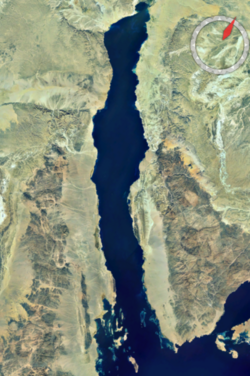
The Gulf of Suez Rift is a continental rift zone that was active between the Late Oligocene (c. 28 Ma) and the end of the Miocene (c. 5 Ma).[1] It represented a continuation of the Red Sea Rift until break-up occurred in the middle Miocene, with most of the displacement on the newly developed Red Sea spreading centre being accommodated by the Dead Sea Transform. During its brief post-rift history, the deepest part of the remnant rift topography has been filled by the sea, creating the Gulf of Suez.
North of the Gulf of Suez the rift becomes indistinct and its exact geometry uncertain, linking eventually to the Manzala rift beneath the Nile delta.[2]
- ^ Khalil, S.M.; McClay K.R. (2001). "Tectonic evolution of the NW Red Sea-Gulf of Suez rift system". In Wilson, R.C.L.; Whitmarsh, R.B.; Taylor, B.; Froitzheim, N. (eds.). Non-Volcanic Rifting of Continental Margins: A Comparison of Evidence from Land and Sea. Special Publication. Vol. 187. Geological Society of London. pp. 453–473. ISBN 978-1-86239-091-1.
- ^ Bosworth, W.; Huchon, P.; McClay, K.R. (2005). "The Red Sea and Gulf of Aden Basins" (PDF). Journal of African Earth Sciences. 43 (1–3): 334–378. Bibcode:2005JAfES..43..334B. doi:10.1016/j.jafrearsci.2005.07.020. Archived from the original (PDF) on 2011-08-18. Retrieved 2010-04-27.